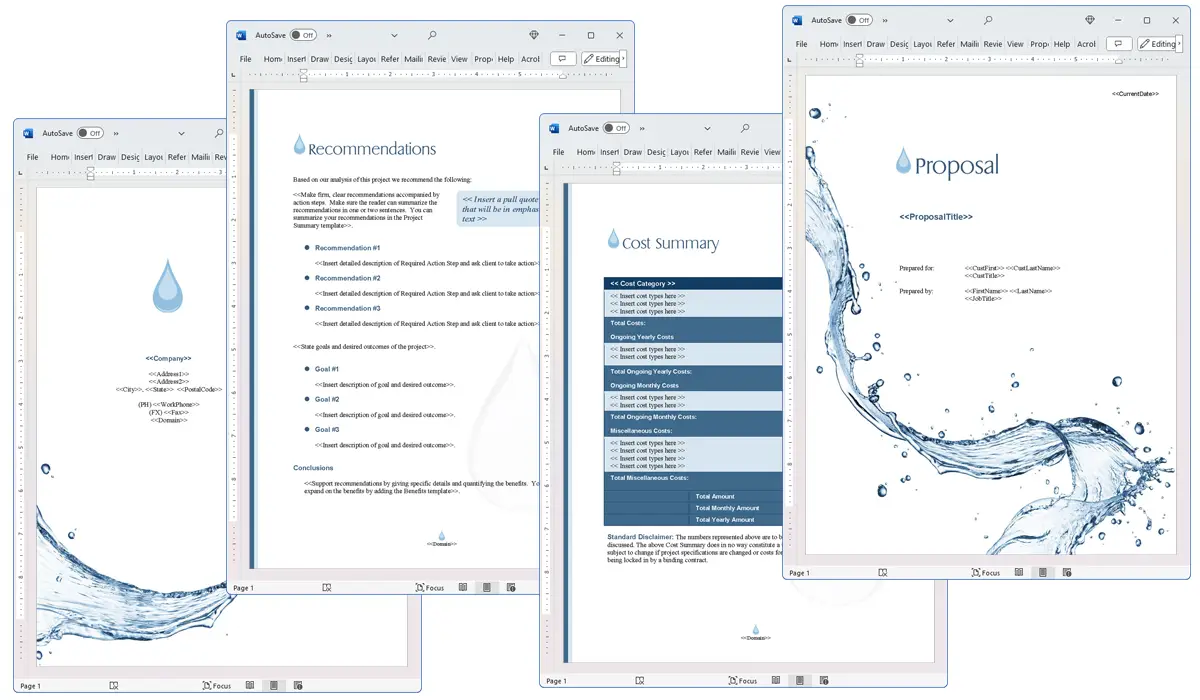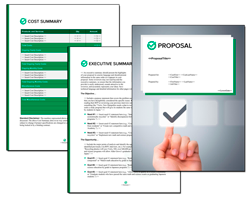What is the Internet chapter used for?
Proposal Kit Professional Bundle adds more design themes, all six Contract Packs,
a project management library, and Expert Edition software.

Illustration of Proposal Pack Aqua #5
We include this Internet chapter template in every Proposal Pack, along with thousands more. You assemble this chapter with others in various combinations to create custom-tailored business proposals, plans, reports, and other documents. Proposal Packs apply custom visual designs to the templates, giving the final documents a consistent professional finish.
 DOWNLOADABLE, ONE-TIME COST, NO SUBSCRIPTION FEES
DOWNLOADABLE, ONE-TIME COST, NO SUBSCRIPTION FEES
Overview of the Internet Chapter
The Internet chapter is a vital part of any business proposal that requires an understanding or integration of internet-related issues. Given the central role that the internet plays in contemporary business operations, this chapter provides a structured way to discuss relevant internet issues withwhen used in a proposal. Whether the proposal involves launching a new online platform, enhancing existing internet infrastructure, or simply outlining the impact of the internet on a given project, the Internet chapter serves as a dedicated section to address these topics comprehensively.
How is the Internet Chapter Used?
In a business proposal, the Internet chapter is used to outline and elaborate on all aspects related to the internet that are important to the project being proposed. This includes detailing the current internet setup, the needs for improvement or expansion, and how the internet will be leveraged to meet business goals. For proposals that are highly technical or web-based, this chapter is crucial for explaining how internet technologies will be used to support the project's objectives. It helps stakeholders understand the technical requirements and the potential impact of the internet on the proposed solution.
What is Included in the Internet Chapter?
The contents of the Internet chapter can vary depending on the specific needs of the proposal, but it typically includes several key elements:
- Current Internet Usage: How the internet is currently being used within the organization or how it impacts the current project.
- Requirements: Specific internet-related needs or enhancements required for the project.
- Benefits: How using the internet or improving internet infrastructure can benefit the project and the organization.
- Challenges and Risks: Potential challenges or risks associated with internet usage in the project, including security concerns.
- Future Outlook: How the internet is expected to influence the future phases of the project or operations.
Use Case Examples for the Internet Chapter
The Internet chapter is and can be adapted for various kinds of proposals. Here are some examples of how it might be used across different industries:
- Web Development Proposals: Detailing the server infrastructure, hosting plans, and content delivery networks.
- IT Infrastructure Projects: Outlining plans for network upgrades, cybersecurity measures, and cloud services.
- Software Deployment: Discussing how internet connectivity affects software functionality and user connectivity.
- Hardware Sales: Demonstrating how internet capabilities can enhance the utility of hardware devices.
- Technical Service Offers: Describing online support services and remote troubleshooting capabilities.
- Physical Items Retail: Explaining e-commerce platforms and online sales strategies.
- Technical Consultancies: Offering insights into optimizing clients' internet presence and operations.
Key Takeaways
- Important Chapter for Modern Proposals: The Internet chapter is crucial for discussing any internet-related aspects in business proposals.
- Versatility: This chapter can be adapted to a wide range of industries and proposal types, from technical projects to e-commerce strategies.
- Detail-Oriented: Provides a structured approach to discussing internet usage, requirements, benefits, and risks.
- Supports Clarity: Helps stakeholders understand the role of the internet in the proposed project, facilitating better decision-making.
- Future Focused: Addresses both current and future impacts of the internet on the project or business operations.

Illustration of Proposal Pack Symbols #8
 What Our Clients Say
What Our Clients SayDon’t let the ’Proposal Pack’ title fool you, this is one of the most comprehensive kits of its kind that I’ve seen and it includes a lot more than just proposals. You get some great templates to help you write business plans, invoices, quotes and more. It served as a useful starting point when putting together complex documents."
Interactive Content Manager at Corus Entertainment
 4.7 stars, based on 847 reviews
4.7 stars, based on 847 reviewsRelated Chapters
- Connections
- Social Networking
- Social Media
- Networking
- Bandwidth
- Online
- Offline
- Technology
- Internet of Things
- Hardware and Software
- Hardware
- Software
- Remote Control
- Uptime
- Web Site Development
- Software Development
- Search Engine Optimization
- Social Content
- Streaming
- Hub
- Information Technology
- Blockchain
- Metaverse
- Digital Delivery
- Everything as a Service

The Internet chapter and other chapters are integrated into a Word document as illustrated here in the Proposal Pack Telecom #3 design theme. There are hundreds of design themes available, and every design theme includes the Internet chapter template.
A proper business proposal will include multiple chapters. This chapter is just one of many you can build into your proposal. We include the complete fill-in-the-blank template in our Proposal Pack template collections. We also include a library of sample proposals illustrating how companies in different industries, both large and small, have written proposals using our Proposal Packs. This template will show you how to write the Internet.
We include a chapter library for you to build from based on your needs. All proposals are different and have different needs and goals. Pick the chapters from our collection and organize them as needed for your proposal.
Using the Proposal Pack template library, you can create any business proposal, report, study, plan, or document.
The Wizard software includes an AI Writer, which will write the content of this and any other chapter of your document. Use the AI Writer to do the heavy lifting, writing the first draft of your proposal or business document in minutes.
 Ian Lauder has been helping businesses write their proposals and contracts for two decades. Ian is the owner and founder of Proposal Kit, one of the original sources of business proposal and contract software products started in 1997.
Ian Lauder has been helping businesses write their proposals and contracts for two decades. Ian is the owner and founder of Proposal Kit, one of the original sources of business proposal and contract software products started in 1997.By Ian Lauder
 Published by Proposal Kit, Inc.
Published by Proposal Kit, Inc.


 Cart
Cart
 Facebook
Facebook YouTube
YouTube Bluesky
Bluesky Search Site
Search Site